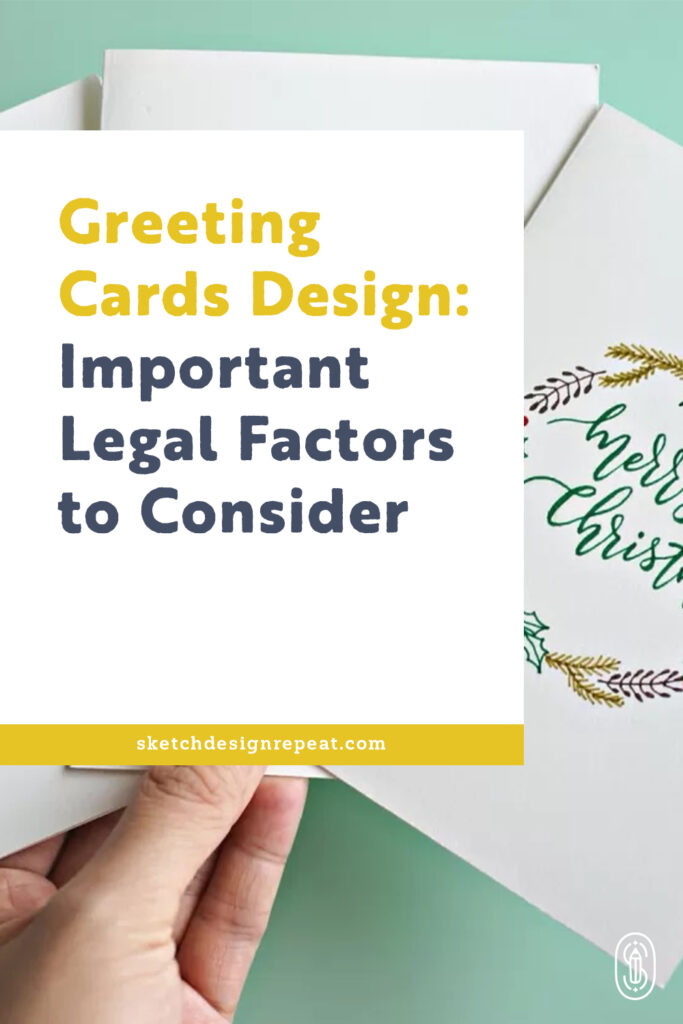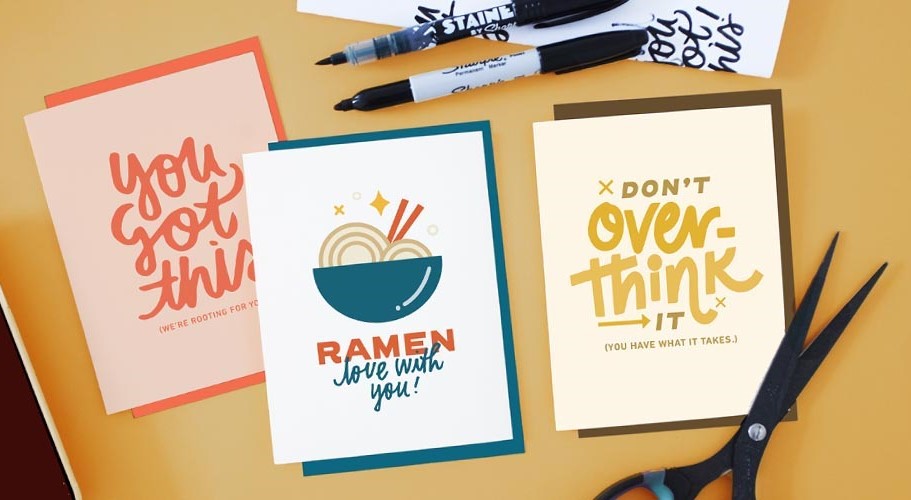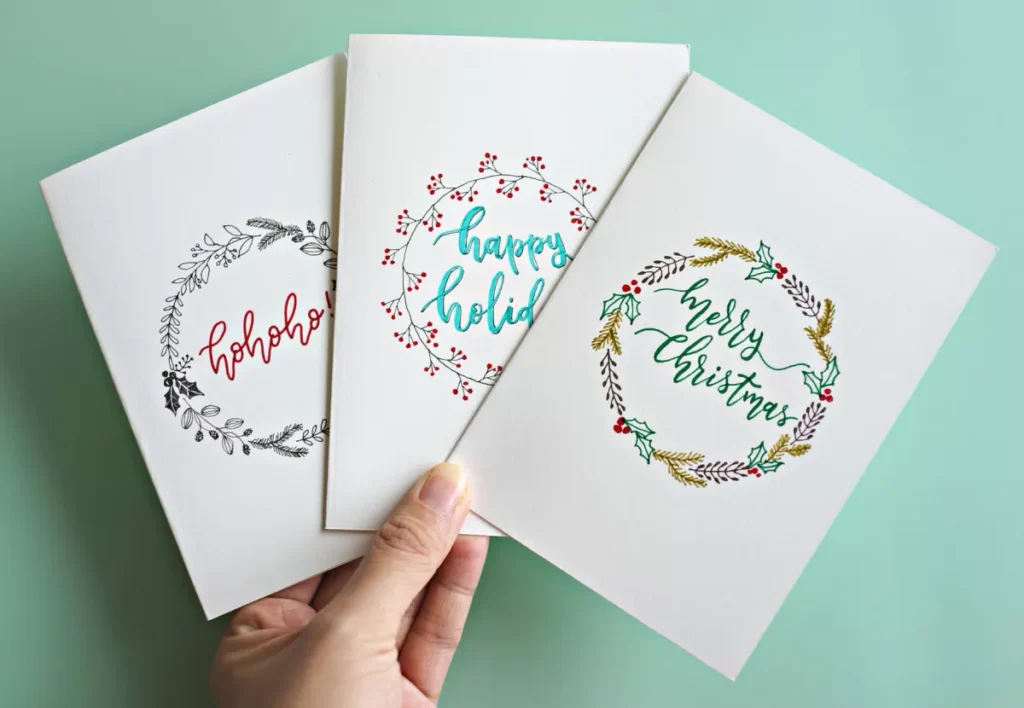Surface pattern designers and illustrators frequently create and sell greeting cards. It seems like a fun and creative business, but there are important legal issues to consider when designing and producing greeting cards for commercial sale. Let’s discuss some key legal areas to keep in mind.

DISCLAIMER: The information contained in this blog post is intended for informational and educational purposes only and should not be construed to constitute legal advice. Before taking any action, or before refraining from taking any action, based on the information contained in this post, please consult an attorney.
1. Copyright Protections
Copyright law protects original works fixed in a tangible medium, which includes greeting card designs. The copyright holder has exclusive rights to reproduce, distribute, publicly display, and make derivative works from their creation.
For greeting cards, copyright covers the words, symbols, graphics, photographs, decorations, and the overall compilation and arrangement of elements that make the design unique. Be sure to always use an original design only — no collages, no borrowing, no copying.
When creating new greeting card designs, it is critical that all aspects are your original work or are properly licensed by third parties. Using substantial portions of copyright-protected material without permission could lead to infringement claims.
Therefore, it’s in your best interest to independently create or license things like text, illustrations, ornamentation, backgrounds, templates, and any recognizable characters. Failure to do so can lead to receiving cease and desist letters or lawsuits seeking monetary damages for the infringement. Registering greeting card copyrights with the U.S. Copyright Office also provides extra legal protections and remedies in case of disputes.
A word about greeting card sayings
The general rule is that short phrases cannot be copyrighted. Phrases like, “yes, chef,” or “goose bumps” are not subject to copyright law because they are short phrases in common language. However, the longer the saying is, the more likely it can be copyrighted. Do not hijack short popular phrases, such as “E.T., phone home.”
Also, the more creative the text, the more likely it will be protected by copyright law. Adding an attribution to your card, where you identify the source of the phrase, can sometimes curb potential infringement claims, but attribution does not fully mitigate copyright infringement.
Also, the greater the amount of borrowed text, especially if it is particularly creative, the more likely it is that it will be protected.
As a rule of thumb, always use your original, creative, or short phrases or text in greeting cards.

2. Trademarking Branding and Logos
If selling greeting cards under a particular brand name or logo, it is advisable to apply for federal trademark registration to protect those identifiers. The name and logo help consumers identify the source of the product.
Trademarks prevent others from using confusingly similar names or logos that could dilute your brand identity.
Before selecting a brand name or logo, do a thorough trademark search to ensure it does not too closely resemble existing marks. The trademark office will reject applications deemed too similar to registered marks. Enforcing rights against trademark infringement can be challenging if your branding conflicts with prior trademarks.
Similarly, do not tread on other entities’ trademarks. Use of another’s trademarked material, image, or logo (like the Nike “swoosh”) without license or permission is trademark infringement and can land you in a whole lot of hot water legally.
Related Article: Design Greeting Cards that Stand Out
3. Respecting Publicity Rights
Many states and countries have laws protecting individuals’ publicity rights, which control the commercial use of their name, image, likeness, or other identifying aspects of identity. This means that depicting or referencing real people on greeting cards requires careful thought. Using someone’s identity without their consent for commercial gain could prompt lawsuits for violating their publicity rights.
The safest legal approach is to only depict fictional characters or real people who have provided signed written consent to appear on the cards.
Don’t include specifics like an individual’s name, photo, or distinctive aspects without advance approval. Consent from celebrities is particularly important given the substantial commercial value of their fame. Violating publicity rights through inappropriate uses can lead to substantial statutory damages.

4. Avoiding Defamation
When writing greeting card text, it is critical to avoid false statements of fact that could damage a person’s or company’s reputation. Defamation consists of untrue statements that injure the subject’s good name or standing if published to third parties. Greeting cards containing falsehoods about real individuals or businesses that harm their reputations could lead to costly defamation lawsuits.
Stick to lighthearted humor and avoid insulting named persons or organizations without their approval. Do not print unprivileged, unflattering depictions or greetings without consent. Making false claims, mocking identifying traits, or depicting real entities offensively creates litigation risks. The best rule of thumb is to get written permission if identifying persons to avoid mistakenly defaming someone.
5. Licensing Third-Party Content
All third-party text, designs, images, or other content used in greeting cards needs to be properly licensed to avoid claims of copyright or trademark infringement. This includes stock photos, clip art, fonts, templates, illustrations created by freelancers, and any other non-original material that is not in the public domain. Failing to obtain licenses to use protected content could again prompt cease and desist demands or federal lawsuits.
It is crucial to research what content is original versus owned by others.
Crediting sources is also important. Hiring designers, writers, or artists to contribute work requires licensing agreements granting print production rights. Keep records of licenses and permissions to prove your legal use rights. Using unlicensed, protected third-party content is an easy way to get in legal trouble.

6. Other Considerations
A few other areas to consider include model releases if depicting identifiable people, warnings for materials that could pose health hazards like glitter or magnets, respecting privacy rights, and avoiding disclosing private facts about individuals without consent.
As a best practice, have an attorney review greeting card designs and disclaimers if you’re unsure. Lastly, secure the necessary business licenses, sales permits, and resale certificates to operate legally.
In Conclusion
Following these guidelines will help safeguard original creations and reduce legal risks when designing and selling greeting cards. Tread carefully regarding unapproved uses of others’ works in your cards. An ounce of prevention is worth a pound of legal cure.
Remember this short phrase: when in doubt, leave it out.

Written by Michael Sheridan, Esquire
Website: www.michaelsheridanesquire.com
Instagram: @michaelsheridandesigns
Michael is a surface pattern designer and commercial litigator with 25 years’ experience. He believes that a strong legal foundation is essential to business success. Michael also is an avid crafter and quilter, specializing in translating ancient Islamic tile patterns into quilt designs.
Great article. Question? When using a photo taken by another person of a live reptile, I enlarged the photo 200% in order to create my stylized pattern. Is this then considered ‘likeness’ ? I did not color it exactly like the photo. I love using type. I have 15 books of typefaces used in the 1970s, front pages on books from Dover publications say, copyright free for use. What then is the percentage that can get used? Many of these companies no longer exist and these typefaces are ‘lost’ in limbo land historically. What is the length than of the original copyright next to an ISBN number? If I take the photo as I do quite often in public groups. Do I need to ask each and everyone of them for permission to use their photo in an illustration? I have been asking parents first before snapping a photo of their children. And getting names / email addresses. This article isn’t for the faint of heart. For I am finding more signs in places stating photographs not allowed, even in public gardens, historic outdoor places and museums that would give me my own photo files of furniture or an ancient vase, etc. In the last year AI has made those signs even more prominent in public and business places. In college in the 1970’s, law class, it was termed Plagiarism. Stealing another’s creative art, words, and photos. This ‘stealing’ has reached epidemic form digitally. Making it near impossible to be a creative artist of any sorts without fear of legal retribution. Our work can be lifted and tracked out of the cloud and reproduced without our knowledge as small entrepreneur, where receiving compensation is hard to do. This is all getting to be very muddy legal water. Creatives have to subscribe to the reproduction programs. Yet each keystroke is laced with legal ramifications. How do we move forward is the greatest question?